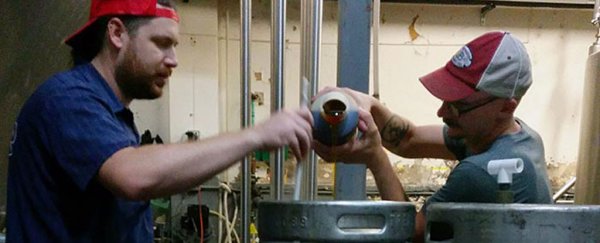There's aged wine and then there's aged wine, and an alcoholic beverage based on an analysis of cauldron sediment dating back some 2,500 years is most definitely the latter.
Researchers in Milwaukee have teamed up with a local craft brewer to recreate this ancient tipple – but before you get too excited about sampling a booze relic hailing from the Iron Age, be warned: it might not be quite suited to modern tastes.
The project is the brainchild of archaeologist and anthropologist Bettina Arnold from the University of Wisconsin-Milwaukee, who uncovered the cauldron in a burial plot back in 2000, during a dig in an area of southwest Germany known as Swabia.
The burial mound, called a tumulus, was built sometime between the 7th and 5th centuries BC. The skeleton inside must have disappeared long ago due to the levels of acid in the soil, but the team suggests he was most probably a male, based on the weapons buried with him: an iron slashing sword, a helmet, and two long iron spears.
But the real prize lay at his feet – a large bronze cauldron, once full of mead. One for the road, so to speak.
"The dead man in Tumulus 17 Grave 6 had been sent into the afterlife not only with his weapons but with about 14 litres of an alcoholic beverage that he could have used to establish himself as an important person in the next world as he had been in this one," Arnold explains on her ancient brew blog.
While this heady brew itself was missing by the time Arnold's team discovered the cauldron – either due to natural processes of evaporation, or perhaps proving popular in its afterlife destination – the researchers carefully excavated the find to see if later analysis in the lab might reveal the drink it once contained.
Investigating a dark residue on the bottom of the vessel, "[w]e actually were able, ultimately, to derive at least some sense of what the contents were in [the] bronze cauldron," Arnold told Bonnie North at NPR.
The team found evidence of a honey-based alcoholic beverage, with traces of two herbs added for flavour: meadowsweet and mint.
The analysis suggests that the cauldron once contained a braggot, a kind of mead consisting of just five ingredients: barley, honey, mint, meadowsweet, and yeast.
Teaming up with a local craft brewer, the researchers did their best to recreate the ancient drop as it would have tasted millennia ago.
According to those who've sampled the finished product, the braggot is certainly drinkable, if considerably tarter than what we tend to drink today.
"I got to sip the final product," writes North for NPR. "The result was smooth and pleasant – almost like a dry port, but with a minty, herbal tinge to it. It also packed an alcoholic kick."
"[Our] version would have been significantly cleaner than the prehistoric one, but we did succeed in producing something that provides those of us with jaded modern palates with a very different flavour profile," explains Arnold.
"The mint actually came through first, which was unexpected, followed by the slightly astringent meadow sweet, but the honey was barely in evidence (having been almost completely converted to alcohol)."
In addition to the lack of sweetness, there's also the strength to consider.
"With an ABV [alcohol by volume] of over 8 percent, this is not your grannie's braggot," Arnold writes, "and although adding honey at this stage would probably make it more drinkable for [contemporary] mead imbibers, we decided to leave it as is."
While the ancient braggot probably won't be doing the rounds at your local – as the brewers don't think it would be something people would want to buy – it's a testament to the power of today's analytical techniques that we can recreate these ancient brews at all.
The researchers' analysis of the sediment has yet to be published, meaning the technique hasn't had a chance to be scrutinised by other researchers. Until it is, we can't know for sure how accurate their recipe is.
But this isn't the first time scientists have used such methods to recreate ancient brews. Previously researchers have given new life to 5,000-year-old Chinese beer and shipwrecked ales sunk off the coast of Finland – beverages once lost to the sands of time, now being tasted again.
Credit of course also has to go to the long-gone cultural practices that saw these ancient alcohols preserved as they were – without them, this little window back into history would remain shut.
"Luckily for us, they didn't just send people off to the afterlife with [swords and spears] – they also sent them off with the actual beverage," Arnold told NPR.
"It's a BYOB afterlife, you know? You have to be able to sort of throw a party when you get there."
